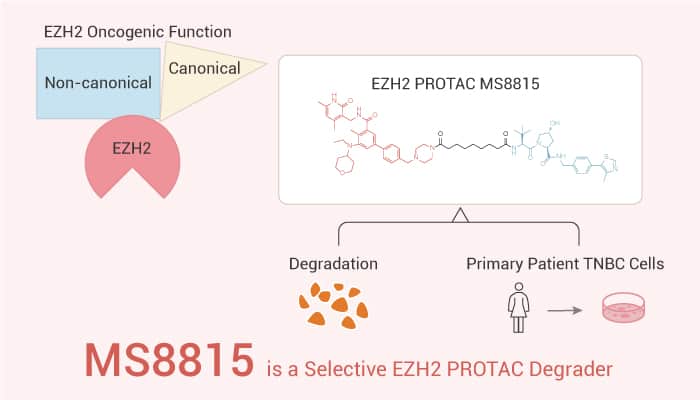Enhancer of zeste homolog 2 (EZH2) is a catalytic subunit of polycomb repressive complex 2 (PRC2). EZH2 drives oncogenesis not only in a canonical H3K27me3-dependent manner but also through non-canonical H3K27me3-independent functions. It exhibits overexpression in triple-negative breast cancer (TNBC).
However, EZH2 catalytic inhibitors are ineffective in suppressing the growth of TNBC cells that are dependent on EZH2. Knockdown of EZH2 inhibits the proliferation of these cells, suggesting that EZH2 protein overexpression but not its catalytic activity is critical for driving TNBC progression.
In this article, we will introduce a potent enhancer of zeste homolog 2 (EZH2) PROTAC degrader, MS8815.

Several PROTAC degrader of EZH2 has been reported, for example, PROTAC YM281. However, they still need to investigate the effects of PROTAC in TNBC cells.
As a potent PROTAC, MS8815 has inhibition activity for EZH2 with an IC50 value of 8.6 nM. Additionally, MS8815 shows potency in inhibiting the EZH2 and EZH1 methyltransferase activity with IC50 values of 8.6 nM and 62 nM, respectively.
In MDA-MB-453 cells, MS8815 (0.1-1 μM) degrades EZH2 with a DC50 value of 140 nM. In multiple TNBC cell lines and primary patient TNBC cells, MS8815 effectively suppresses cell growth. It induced nearly complete degradation of EZH2 and exhibited the most robust degradation at 0.3 μM. Additionally, MS8815 (0.1-10 μM; 5 days) effectively suppresses the cell growth
MS8815 is used for the research of triple-negative breast cancer (TNBC).
In conclusion, MS8815 effectively reduced the EZH2 protein level in a concentration-, time-, and UPS-dependent manner in a variety of TNBC cells. It is also able to degrade other PRC2 core components, EED and SUZ12, and the H3K27me3 mark. Additionally, this PROTAC was highly selective for EZH2 over other protein methyltransferases except for EZH1. Phenotypically, EZH2 PROTAC degraders MS8815 and YM281 displayed anti-proliferative activities much superior to those of EZH2 inhibitors EPZ-6438 in multiple TNBC cell lines
Reference:
1.Brandon Dale, et al. ACS Pharmacol Transl Sci. 2022 Jun 24;5(7):491-507.